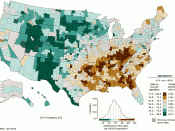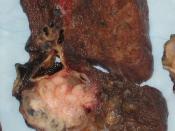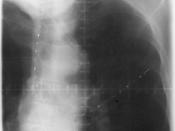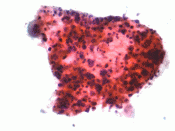In 2002, the American Cancer Society reported that more than 150,000 Americans die from the disease every year. Only 15 percent of people with lung cancer will live five years. Cancer is when cells in a part of the body begin to grow out of control. Small cell lung cancer is due more to smoking. Although small cell lung cancer "(SCLC) is due more to smoking, it may also be inherited.
There are 2 main types of lung cancers and they are both treated differently. Small cell lung caner (SCLC) and non small cell lung cancer (NSCLC). About 10% to 15% of all lung cancer is small cell. Most lung cancer is started in the bronchi of the lungs, but can start in other parts also. First there may be pre -cancerous changes in lung, there may not be a mass or tumor shown in the x-ray, or chest scan and do not cause any symptoms.
Over time these pre-cancerous growths may grow on to be a true cancer. Cancer gives out chemicals that flow into the bloodstream, nourishing the tumor to form. Finally the tumor forms big enough to show on the x-ray or chest scan.
If the cancer is a mix small cell lung cancer (SCLC) and non small cell lung cancer (NSCLC) it is called mix small/non small lung cancer.
Some growths of cancer on lungs are cancerous, others are not. Carcinoid tumors are small and grow slowly and usually cured by surgery. One of the ways cancer is spread is thru the lyphmatic system. When the lung cancer has reached the lymp nodes, most likely it has already spread to other organs of the body. If cancer has spread to the other lung, to lymph node on the other side of chest or distant organs, it's called extensive stage.
For small cell lung cancer, a 2-stage system is used most often. This system splits small cell lung cancers into limited stage and exstensive stage. Limited stage means the cancer is only in te lungs, maybe the lymph nodes, but same side as the cancer if found. Staging is a way for doctors to know how large the cancer is, and to acnowlege if it has spread or not. A more formal system to describe the growth and spread of lung cancer is the TMN Staging System. Stages are described useing a roman numeral 0-IV (0-4). Some stages are futher divided to A and B. In general, the lower the number, the less the cancer has spread. A higher number means the more seriousness of a cancer. The higher the number means that the cancer also could have spread to other areas of the body.
The TMN Staging System, is used more on non-small cell lung cancer, because treatment options and outlook vary from the two diffrent kinds of cancer. Small cell lung cancer is staged in this way because it helps to seperate people who can be treated with radiation and cheamotheraphy (limited stage), than those who can't be treated (exstensive stage).
When it comes to cancer, there are many diffrent ways to get the theraphy. Whether it's radiation, chemotheraphy, or surgery, they are all ways to help you with curing the cancer. Chemotheraphy is use of drugs to treat a type of cancer. Most of the time you can just hear the name "Chemo" used for short. When receiving chemotheraphy, you will most likely lose your hair. Sometimes only mild hair thinning will occur. If you do lose your hair, it will almost always grow back after your treatments have stopped. Therefore when it dose grow back, it could be diffrent color or texture.
The goal of Chemotheraphy is to: cure cancer, keep cancer from spreading, slow cancer growth, kill cancer cells that may have spread to other parts of the body from the original tumor, and to releive symptoms caused by cancer. When taking chemotheraphy, be sure to watch your fluids and to never over work yourself.
You may be worried about paying for all the treatments, and thats just normal. If your unemployeed, check if your reginal/state has bennifeits such as medicade. If you are employeed, check with your employer about insurance, and see if you can get an individual plan. If your looking for insurance options, be sure to check the diffrences in average for cancer treatments.
After you have reached the end of your treatments, you may feel releived. But with all the joy, there is some risks it may return (reoccurance). After your treatments, it's not about getting back to your old self, it's about getting to the new you, and whats going to be normal to you. Normal before is way diffrent to whats normal now.
When going to the doctor, take a friend, or relative with you. They can help you understand what the doctors are trying to say to you. Make a list of questions to take to the doctor. Your questions are very importaint. Also, take notes! The notes can help you refer back later. But most of all, do not hold back or be scared, people are there to help you.
Some sample questions to ask the doctor include: What was the goal of my chemotheraphy? What were the chances the chemotheraphy will work? Am I in full remission? Plus many more. In general, survivors usually return to the doctor every 2 to 3 years after treatment, and once or twice a year after that. At these visits the doctor will look for side effects from the treatment and check for reoccurance (return of cancer) or spread (metastisized) to another part of your body. Follow up tests may include blood tests, MRI, CT Scans, and endoscopy.
Cancer it's self is a scary word. Knowing what to do right and wrong helps. Your detection, treatment ,and treatment after life is very importaint. There are many things out there to help people with lung cancer. Try to live everyday to the fullest, and never give up!





